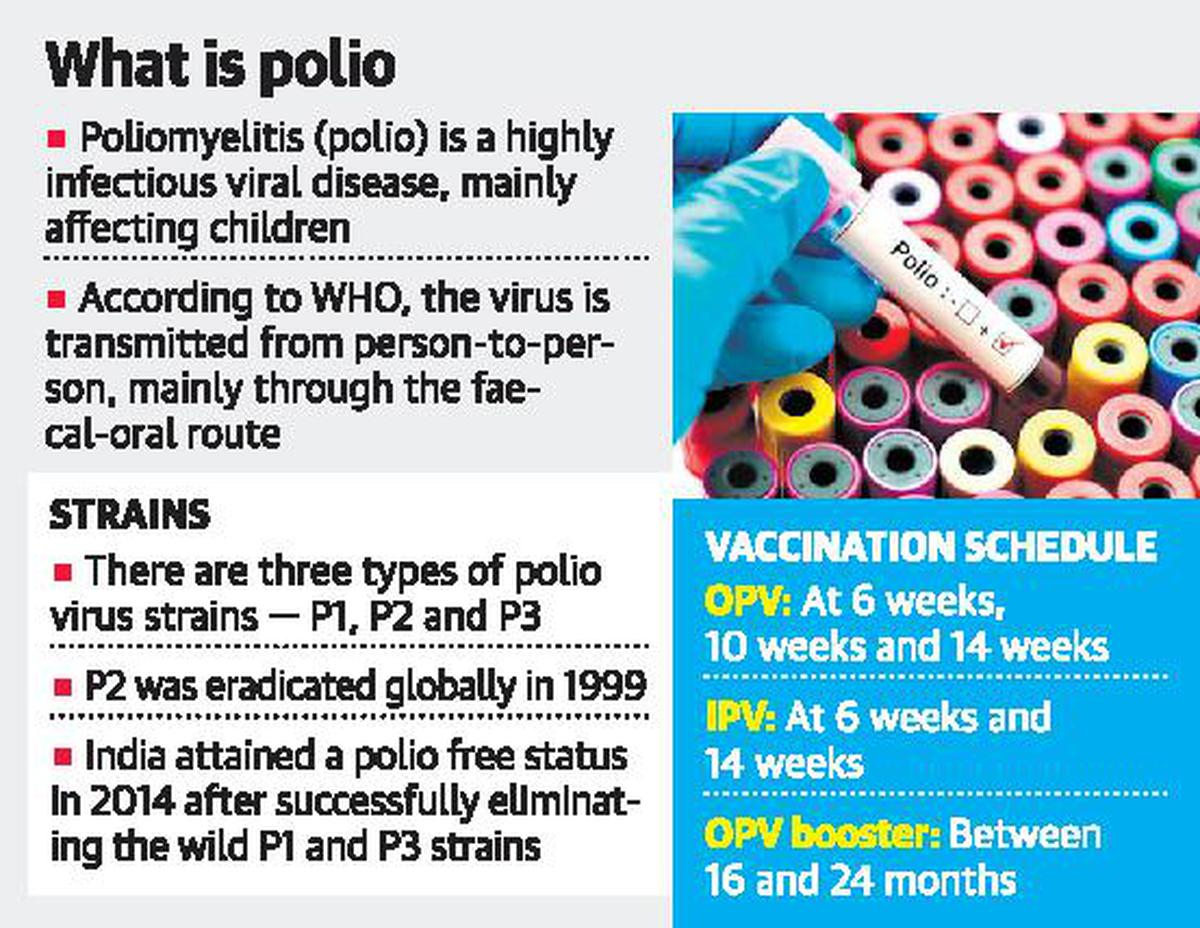Development of Polio Vaccines | 05 Jul 2024
For Prelims: Polio, Vaccine Derived Poliovirus, WHO, Universal Immunization Programme
For Mains: Poliovirus, Polio Immunization and Eradication Programmes in India and the world, WHO Programmes on Polio.
Why in News?
The wild poliovirus is beginning to reappear in big cities in Afghanistan and Pakistan, due to vaccine hesitancy, misinformation, conflict, poverty, and limited access to these isolated regions.
- As a result, the World Health Organization's Global Polio Eradication Initiative is set to miss its deadline of eradicating polio by the end of 2026.
- The two vaccines namely Inactivated Polio Vaccine (IPV) and Oral Polio Vaccine (OPV) have helped in nearly eradicating polio from the world.
What is the History of Development of Polio Vaccines?
- The development of the 2 polio vaccines - the Inactivated Polio Vaccine (IPV) by Jonas Salk and the Oral Polio Vaccine (OPV) by Albert Sabin was a result of several key breakthroughs:
- Culturing the Poliovirus in Non-Nerve Cells:
-
In 1948, microbiologists discovered a method to grow the poliovirus in human muscle and skin cells, rather than just in nerve cells as was previously believed.
- This allowed for the mass production of the poliovirus, which was crucial for vaccine research and development.
-
- Development of the Inactivated Polio Vaccine (IPV):
-
Jonas Salk developed the first successful polio vaccine by growing the poliovirus, inactivating it and injecting it into test subjects.
-
The IPV generated systemic immunity, as it was introduced into the muscle.
-
-
Development of the Oral Polio Vaccine (OPV):
-
Albert Sabin developed the OPV, which contained live, weakened poliovirus strains that were administered orally.
- The OPV induced a powerful protective mucosal immune response in the gut, where the virus begin its infection.
-
- Culturing the Poliovirus in Non-Nerve Cells:
Note
- The immune system has 2 main parts: the systemic (including the blood, brain, and other organ systems) and the mucosal (including the inner linings of the digestive and respiratory systems, urogenital tract, and eyes).
- Mucosal components are lined with mucous membranes for additional protection due to frequent contact with the external environment.
What are Advantages and Disadvantages of IPV and OPV?
| Inactivated Polio Vaccine (IPV) | Oral Polio Vaccine (OPV) |
|
Advantages:
Disadvantages:
|
Advantages:
Disadvantages:
|
Note:
The world has utilised both vaccines in the fight against polio.
- Some countries, such as Norway, Sweden, Finland, and Iceland, relied exclusively on the IPV.
- Most countries, however, used a combination of the two vaccines.
- These countries preferred the OPV for its superior protection and ease of administration, and then switched to the IPV when the number of natural polio cases drops to zero.
What are the Key Facts about Polio?
- Polio (poliomyelitis) is a highly infectious viral disease that enters the body through the mouth, multiplying in the intestine before invading the nervous system.
- It mainly affects children under 5 years of age.
-
The incubation period for poliovirus is usually 7–10 days, but it can range from 4–35 days.
-
- Initial symptoms of poliovirus infection include fever, fatigue, headache, vomiting, stiffness in the neck, and pain in the limbs.
- Up to 90% of those infected with poliovirus experience no or mild symptoms, often going unrecognised.
- One in 200 infections leads to permanent paralysis of the legs, which can occur within a few hours of infection.
- 5-10% of those paralyzed by polio virus die when their breathing muscles become immobilised.
- The virus is shed by infected people, usually children, through faeces, and can spread quickly in areas with poor hygiene and sanitation systems.
- Cases due to wild poliovirus have decreased by over 99% since 1988, from an estimated 350 000 cases in more than 125 endemic countries, to just 2 endemic countries Afghanistan and Pakistan (as of October 2023).
- India received polio-free certification by the WHO in 2014, after three years of zero cases.
What are the Measures Taken to Eradicate Polio?
- Global:
-
Global Polio Eradication Initiative: It was launched in 1988 by national governments and spearheaded by the WHO, Rotary International, the United States Centers for Disease Control and Prevention (CDC), and the United Nations Children's Fund (UNICEF).
-
World Polio Day: It is observed every year on 24th October in order to call on countries to stay vigilant in their fight against the disease
-
-
India:
-
Universal Immunization Programme (UIP): It was launched in 1985 with the modification to ‘Expanded Programme of Immunization (EPI). The objectives of the Programme include:
- Rapidly increasing immunisation coverage, Improving the quality of services, Establishing a reliable cold chain system to the health facility level, Introducing a district-wise system for monitoring of performance, Achieving self-sufficiency in vaccine production.
Read more: Guinea Worm Disease
UPSC Civil Services Examination, Previous Year Question
Q. ‘Mission Indradhanush’ launched by the Government of India pertains to (2016)
(a) immunisation of children and pregnant women
(b) construction of smart cities across the country
(c) India’s own search for the Earth-like planets in outer space
(d) New Educational Policy
Ans: (a)
Q. Which of the following are the objectives of ‘National Nutrition Mission’? (2017)
- To create awareness relating to malnutrition among pregnant women and lactating mothers.
- To reduce the incidence of anaemia among young children, adolescent girls and women.
- To promote the consumption of millets, coarse cereals and unpolished rice.
- To promote the consumption of poultry eggs.
Select the correct answer using the code given below:
(a) 1 and 2 only
(b) 1, 2 and 3 only
(c) 1, 2 and 4 only
(d) 3 and 4 only
Ans: (a)

